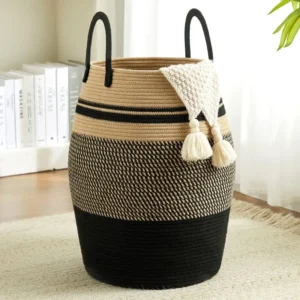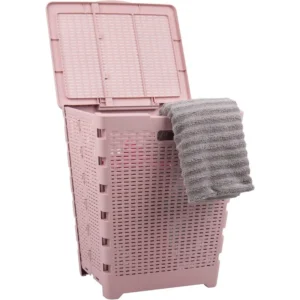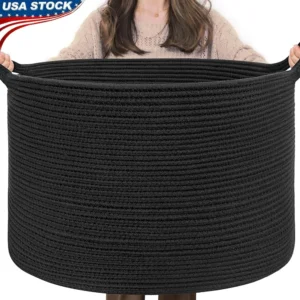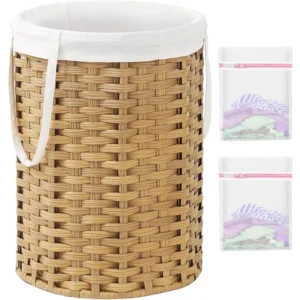1. Introduction: Finding the Perfect Laundry Storage Solution
A well-organized home starts with thoughtful storage solutions, and few items are as essential as proper laundry organizers. The right laundry storage does more than just collect dirty clothes—it enhances your space, streamlines your routine, and brings a touch of elegance to an otherwise mundane necessity.
When it comes to laundry management, two main options dominate the market: hampers and baskets. Though they might seem interchangeable, each serves a distinct purpose in the laundry workflow. Hampers are primarily designed as stationary collection points where dirty clothes gather until wash day, while baskets excel as transportation tools, carrying clean or dirty laundry between locations.
At Tidy Treasure, we believe that practical items don’t have to sacrifice beauty. Our premium storage solutions transform everyday necessities into design elements that complement your home’s aesthetic while performing their essential functions flawlessly.
| Feature | Laundry Hampers | Laundry Baskets |
|---|---|---|
| Primary Function | Collection & Storage | Transportation |
| Typical Design | Taller, stationary | Wider, portable |
| Mobility | Generally stays in one place | Designed to be carried |
| Common Materials | Wicker, fabric, bamboo, plastic | Plastic, wicker, canvas |
| Typical Features | Lids, ventilation, liners | Handles, open tops |
Understanding the differences between choosing between hampers and baskets is the first step toward creating an efficient laundry system that works seamlessly with your lifestyle and home design.
2. Understanding Laundry Hampers: Definition, Types, and Uses
A laundry hamper is primarily a stationary collection point designed to store dirty clothes between wash days. Unlike baskets, hampers are typically taller than they are wide, with dimensions often ranging from 24-30 inches in height and 14-18 inches in diameter or width. Most standard hampers hold between 2-3 bushels of laundry (approximately 1.5-2 full loads).
Hampers are characterized by several key features that distinguish them from other laundry storage options:
- Stationary design: Meant to remain in a fixed location, usually in bedrooms, bathrooms, or closets
- Vertical construction: Taller than wide to maximize floor space efficiency
- Containment focus: Often include lids to conceal contents and control odors
- Material variation: Available in numerous materials to match different interior styles
Common Hamper Materials:
- Wicker & Rattan: Natural, breathable materials that offer rustic charm and excellent ventilation
- Fabric: Lightweight, often collapsible options with removable liners for easy cleaning
- Bamboo: Eco-friendly alternative with natural antimicrobial properties
- Plastic: Durable, moisture-resistant options often found in bathrooms
- Wood: Solid construction that can double as furniture pieces
The design of wicker hampers with lids provides both aesthetic appeal and practical functionality, hiding dirty laundry while allowing air circulation to prevent musty odors. Many premium hampers include ventilation holes or slats to promote airflow, removable liners for easy transport to the washing machine, and sorting compartments for pre-organizing laundry by color or fabric type.
Understanding the fundamental laundry hamper vs basket differences helps determine which option best suits your specific needs. Hampers excel in spaces where dirty clothes need to be stored for several days while maintaining a tidy appearance.
3. Understanding Laundry Baskets: Definition, Types, and Uses
Laundry baskets differ fundamentally from hampers in both design and purpose. While hampers collect and store dirty clothes, baskets are primarily transportation tools designed to move laundry between locations. Their dimensions typically favor width over height, with most measuring 18-24 inches wide, 12-18 inches deep, and 8-12 inches tall.
The defining characteristics of laundry baskets include:
- Portable design: Lightweight construction with carrying handles
- Open-top configuration: Easy access for loading and unloading
- Wide, shallow shape: Facilitates easy access to contents
- Ergonomic features: Contoured sides, comfortable handles
Common Basket Materials:
- Plastic: Lightweight, easy to clean, and moisture-resistant
- Wicker & Natural Fibers: Attractive, breathable options that add texture and warmth
- Canvas/Fabric: Soft-sided, often collapsible for storage when not in use
- Hybrids: Combinations like plastic frames with fabric liners
Laundry baskets are designed with transportation in mind, featuring reinforced handles positioned for balanced weight distribution. Most quality baskets can comfortably carry 15-25 pounds of laundry—approximately one full load of wet clothes—without straining.
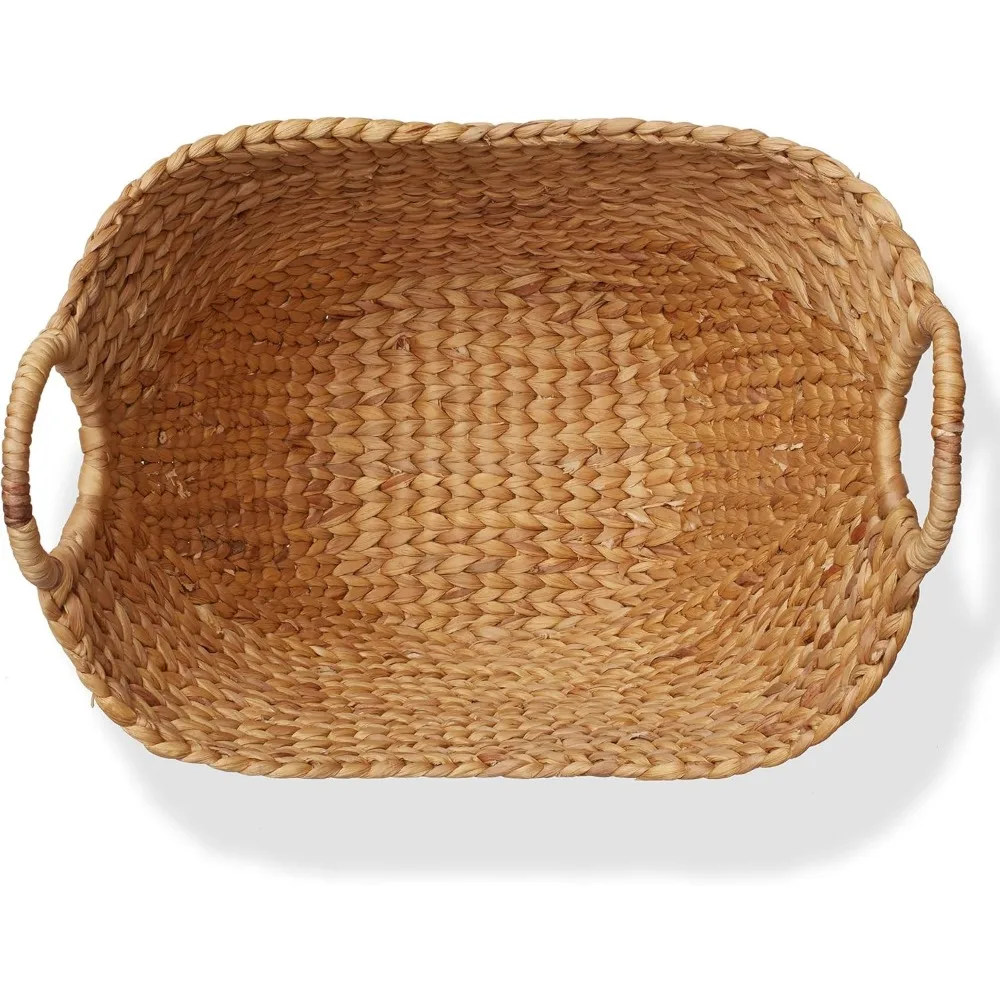
The simple yet functional design of woven laundry baskets makes them ideal for carrying folded clean clothes back to bedrooms, transporting dirty laundry to the washing machine, or temporarily holding items during household organization tasks. Many homeowners find that having multiple baskets allows for efficient sorting and distribution of clean laundry among family members.
Unlike hampers, baskets are rarely left in visible living areas when not in use, though decorative versions can serve dual purposes as attractive storage for blankets or pillows when not being used for laundry.
4. Key Differences: Hampers vs. Baskets Compared
When choosing between laundry hampers and baskets, understanding their key differences helps determine which option—or combination—will best serve your needs.
| Feature | Laundry Hampers | Laundry Baskets |
|---|---|---|
| Primary Function | Storage/Collection | Transportation |
| Typical Location | Bedrooms, bathrooms, closets | Laundry rooms, moving between rooms |
| Portability | Low – stays in one place | High – designed to be carried |
| Design | Tall, narrow footprint | Wide, shallow design |
| Top Configuration | Often lidded | Almost always open |
| Visibility | Conceals contents | Contents visible |
| Handles | May have side handles | Prominent carrying handles |
| Weight When Full | Can be heavy to move | Designed for comfortable carrying |
| Duration of Use | Long-term storage (days) | Short-term use (hours) |
Structural Considerations
Hampers prioritize concealment and storage efficiency, often incorporating lids that hide dirty laundry from view and help contain odors. Their vertical design maximizes floor space but can make retrieving items from the bottom challenging. In contrast, baskets feature open tops for easy access, with wide openings that make loading and unloading simple.
Aesthetic Integration
From a design perspective, hampers are often selected to complement room décor since they remain visible in living spaces. Premium options like handwoven wicker or rattan hampers serve as decorative elements that enhance a room’s aesthetic. Baskets, being primarily functional and often stored away when not in use, may place less emphasis on decorative features, though finding your perfect laundry basket or hamper companion often involves considering both form and function.
Space Efficiency
Hampers generally have a smaller footprint but extend vertically, making them ideal for corners or narrow spaces. Baskets spread horizontally but can often be nested or collapsed when not in use, offering flexibility for storage. Understanding these distinctions helps in choosing your complete wicker laundry solution that fits both your space constraints and functional requirements.
5. Material Considerations: Choosing the Right Construction
The material of your laundry storage solution significantly impacts its durability, appearance, and functionality. Premium natural materials offer distinct advantages for discerning homeowners seeking both beauty and practicality.
Natural Fiber Options
Wicker & Rattan: These traditional materials create hampers and baskets with exceptional breathability, preventing the musty odors that can develop in non-ventilated containers. Quality wicker construction is identified by:
* Consistent, tight weaving patterns with no loose ends
* Smooth, finished edges that won’t snag clothing
* Sturdy, reinforced handles that won’t separate from the body
* Natural variations in color that add character
Seagrass & Water Hyacinth: These sustainable materials offer excellent durability and a distinctive textural element:
* Naturally water-resistant properties
* Tight, intricate weaving patterns
* Slight variations in color creating visual interest
* Expected lifespan of 5+ years with proper care
Fabric Options
Canvas: Durable cotton canvas offers washability and soft edges:
* Machine-washable convenience
* Available in various patterns and colors
* Often features collapsible frames for storage
* Typical lifespan of 3-4 years with regular use
Polyester Blends: These provide durability with added water resistance:
* Resistant to mildew and moisture damage
* Lightweight construction for easy movement
* Often less expensive than natural alternatives
* Typically lasts 2-3 years before showing wear
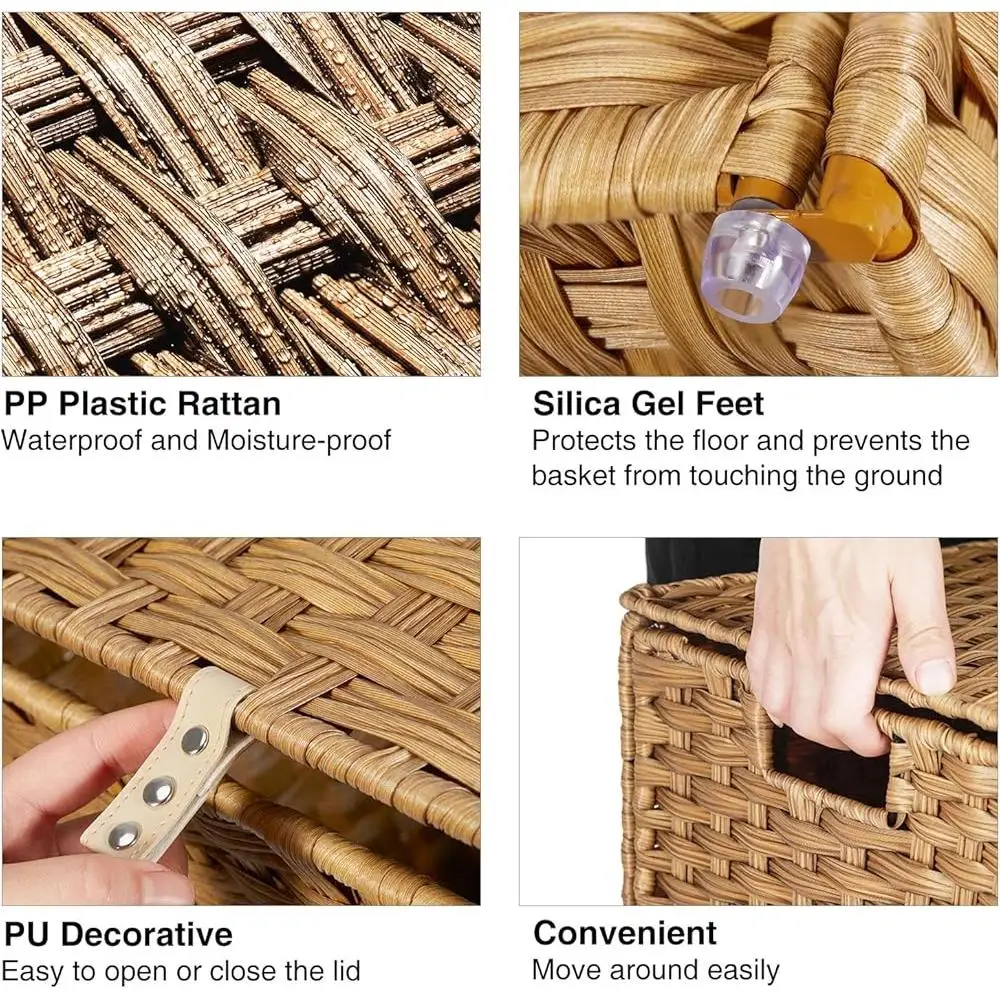
The craftsmanship evident in rattan laundry baskets illustrates why material selection matters. Superior construction features like double-weaving at stress points, reinforced rims, and properly finished edges significantly extend the product’s lifespan and maintain its appearance over time.
Natural materials generally require slightly more maintenance than synthetic alternatives but offer superior aesthetics and often better functionality through improved airflow. For homes with a focus on organic elements and natural décor, the visual warmth of wicker or rattan creates a cohesive design statement while performing essential organizational functions.
6. Essential Buying Factors: Size and Capacity
Selecting the appropriate size for your laundry storage solution ensures it will effectively meet your household’s needs without overwhelming your space.
Sizing Guide Based on Household Size
| Household Size | Recommended Hamper Capacity | Recommended Basket Size | Weekly Laundry Volume |
|---|---|---|---|
| Single person | 1.5-2 bushels (12-16 gallons) | Medium (1.5 bushels) | 2-3 loads |
| Couple | 2-2.5 bushels (16-20 gallons) | Large (2 bushels) | 3-5 loads |
| Family of 3-4 | 3+ bushels (24+ gallons) or multiple hampers | Extra-large (2.5+ bushels) | 5-9 loads |
| Family of 5+ | Multiple hampers totaling 4+ bushels | Multiple baskets or extra-large | 8+ loads |
Space Measurement Tips
Before purchasing, measure your intended placement area carefully, considering both floor space and height requirements. Allow for:
* 2-3 inches of clearance around the hamper for air circulation
* Sufficient height clearance if the hamper will be placed in a closet or under a counter
* Door swing space if your hamper has a lid that opens upward
* Width of doorways through which baskets will need to pass
For homes with limited space, consider tall, narrow hampers that maximize vertical storage while minimizing floor footprint. Alternatively, large wicker laundry baskets can serve dual purposes as both collection and transportation vessels, eliminating the need for separate hampers.
Seasonal Considerations
Many households experience significant seasonal variations in laundry volume due to:
* Bulkier winter clothing and bedding
* Additional beach towels and outdoor gear in summer
* Sports uniforms during school seasons
* Holiday linens and guest accommodations
When sizing your laundry storage, consider your peak volume periods and either select for this capacity or plan for supplementary solutions during these times.
7. Portability Features: Handles, Wheels, and Weight Considerations
The ability to move your laundry storage easily between locations significantly impacts its functionality in daily use. When evaluating portability features, consider how the design supports comfortable handling when loaded with heavy clothes.
Handle Design and Ergonomics
Handles represent the most critical portability feature, particularly for laundry baskets:
- Integrated handles: Woven directly into the basket structure, providing a seamless appearance but potentially less comfortable for heavy loads
- Cut-out handles: Openings in the basket sides allowing for a secure grip, ideal for plastic baskets
- Over-rim handles: Fabric or rope handles that extend over the basket rim, distributing weight evenly but potentially causing hand strain with heavier loads
- Extended handles: Longer grips that allow the basket to be carried at hip level rather than knees, reducing back strain
For maximum comfort, handles should:
* Be at least 1-1.5 inches wide to distribute pressure
* Feature smooth finishes without sharp edges
* Provide 3-4 inches of clearance for hands
* Be positioned to balance the load when full
Wheel Considerations for Hampers
For larger hampers, wheels add significant convenience:
* Swivel casters: Allow for omnidirectional movement, ideal for navigating tight spaces
* Fixed wheels: Provide stability and directional control
* Locking mechanisms: Prevent unwanted movement when stationary
* Wheel material: Soft rubber minimizes noise and protects floors
When considering hampers versus baskets for small laundry spaces, portability features become even more crucial, as multi-functional pieces must transition seamlessly between roles.
Weight Distribution
The structural design of baskets significantly impacts how weight is distributed when carried:
* Oval or rectangular baskets distribute weight more evenly across both arms
* Round baskets may cause the load to shift during transport
* Contoured sides that follow body curves reduce strain by keeping the load closer to the carrier’s center of gravity
* Reinforced bottoms prevent sagging when carrying wet, heavy loads
8. Design and Style: Integrating Laundry Solutions with Home Décor
The most successful laundry storage solutions serve as design elements that enhance your home’s aesthetic rather than detract from it. Premium options bridge the gap between pure utility and decorative accessories.
Matching Storage to Interior Design Styles
Modern/Minimalist: Opt for clean lines, monochromatic colors, and simple geometric shapes. Look for:
* Sleek hampers with hidden lids
* Natural materials in uniform tones
* Geometric weaving patterns
* Absence of ornate details
Traditional: Choose classic forms with warm finishes and familiar silhouettes:
* Round or oval wicker baskets with traditional weaving patterns
* Rich, warm-toned natural materials
* Slightly more ornate detailing
* Classic proportions
Farmhouse/Rustic: Emphasize texture and natural materials:
* Loosely woven water hyacinth or seagrass
* Visible natural color variations
* Rope handles or leather accents
* Imperfect, handcrafted appearance
Coastal: Focus on light colors and casual textures:
* Whitewashed or light-toned wicker
* Blue and white color combinations
* Rope or nautical-inspired details
* Relaxed, unfussy silhouettes
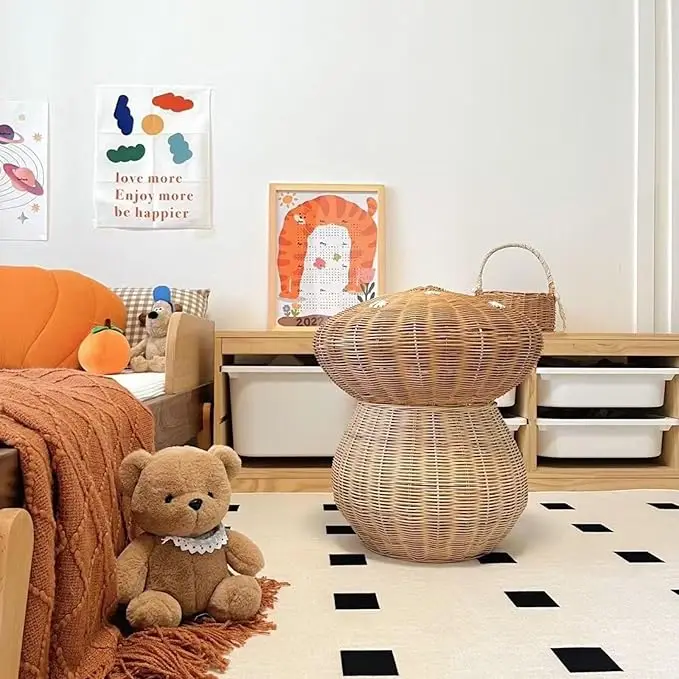
Visibility Considerations
When selecting stylish hampers and baskets for your home, consider whether the item will be prominently displayed or tucked away:
- High-visibility locations (bedrooms, bathrooms): Choose pieces that coordinate with room colors and materials
- Medium-visibility (closets, behind doors): Focus on function but maintain consistent material quality
- Low-visibility (laundry rooms, utility spaces): Prioritize function while maintaining quality construction
For pieces that will be visible in living spaces, consider:
* How the texture complements existing furniture
* Whether the color enhances or clashes with your palette
* If the scale is appropriate for the space
* How the piece contributes to the room’s overall design language
Well-chosen laundry storage can actually elevate a space, adding texture, warmth, and organic elements that enhance the overall design while performing essential organizational functions.
9. Special Features Worth Considering
Specialized features can transform basic laundry storage into customized solutions that address specific needs and preferences.
Lid Options and Benefits
The decision between lidded versus open laundry hampers impacts both functionality and appearance:
Hinged Lids:
* Allow one-handed operation
* Stay attached to prevent misplacement
* Often include slow-close mechanisms
* May require additional clearance for opening
Removable Lids:
* Provide complete access when removed
* Can double as secondary baskets or trays
* Often feature decorative finials or handles
* Allow for easier loading of bulky items
Flip-Top Lids:
* Offer convenient access through partial openings
* Keep contents concealed when closed
* Typically include magnetic or mechanical closures
* Work well in tight spaces
Sorting and Organization Systems
Advanced hampers include features that streamline the laundry process:
Multiple Compartments:
* Typically divided into 2-3 sections
* Allow pre-sorting of whites, darks, and colors
* Each compartment usually holds 1-1.5 bushels
* May feature color-coded or labeled dividers
Removable Dividers:
* Offer flexibility to adjust compartment sizes
* Allow conversion between sorted and unsorted use
* Typically attach via slots or hooks
* Can be removed for washing
Liner Considerations
Quality liners enhance functionality and extend hamper life:
Material Options:
* Cotton: Breathable and machine-washable
* Polyester: Moisture-resistant and durable
* Mesh: Maximum ventilation but less concealment
* Waterproof: Ideal for damp items or bathroom use
Attachment Methods:
* Velcro tabs: Easy removal but less secure
* Drawstring: Adjusts to fit various hamper sizes
* Elastic edges: Snug fit without fasteners
* Snap fasteners: Secure placement with easy removal
Most premium liners are designed to be removed and washed every 2-4 weeks, significantly extending the life of the hamper while maintaining hygiene.
10. Strategic Placement: Where to Position Laundry Storage
Thoughtful positioning of your laundry storage solutions enhances both convenience and aesthetic integration within your home.
Bedroom Placement
- Position hampers in closets or dressing areas for easy access during changing
- Consider height and accessibility relative to bedroom furniture
- Allow 12-18 inches of clearance in front for comfortable access
- For shared bedrooms, consider dual compact hampers rather than one large unit
Bathroom Considerations
- Select moisture-resistant materials like sealed wicker or ventilated plastic
- Position away from direct water splash zones
- Consider narrow, vertical designs for limited floor space
- Look for units that fit between fixtures or under counters
Laundry Room Organization
- Place sorting hampers near the entrance for immediate organization of incoming laundry
- Position baskets on counters or dedicated shelving when not in use
- Allow 24-36 inches of open floor space for loading/unloading washing machines
- Consider wall-mounted or stacking options to maximize floor space
Multi-Unit Systems
For larger households, a strategic combination of wicker laundry hampers throughout the home creates an efficient collection system:
- Primary hampers in each bedroom for individual collection
- Secondary hamper in bathrooms for towels and washcloths
- Transport baskets stored in the laundry area for moving clean clothes
- Sorting station in the laundry room for final pre-wash organization
Creating designated drop zones with appropriate storage vessels encourages family members to properly contain dirty laundry rather than leaving it on floors or furniture.
11. Lifestyle-Based Solutions: Finding Your Perfect Match
Your ideal laundry storage system should align with your specific living situation, family composition, and laundry habits.
For Small Space Living
Apartments, condos, and compact homes require thoughtful solutions:
* Collapsible hampers that can be stored when not in use
* Over-door hanging options that utilize vertical space
* Dual-purpose pieces that serve as hampers and transport vessels
* Narrow, tall designs that minimize floor footprint
For Families with Children
Kid-friendly features encourage participation in laundry routines:
* Color-coded sorting systems to teach organization
* Lightweight baskets sized for children to help carry
* Hampers with easy-open lids that won’t pinch fingers
* Durable construction that withstands rougher handling
For Active Households
Homes with athletes or outdoor enthusiasts have unique needs:
* Ventilated hampers for sweaty workout clothes
* Moisture-resistant liners for damp items
* Extra-capacity options for bulky sports gear
* Separate hampers for heavily soiled items
The comparison between laundry hampers and baskets becomes particularly important when designing a system for varied needs. Many households benefit from a hybrid approach, using stationary hampers for collection and designated baskets for transport.
For Frequent Launderers vs. Weekly Washers
Your laundry schedule significantly impacts your optimal storage solution:
* Daily launderers may prefer smaller, easily transportable options
* Weekly washers need larger capacity storage with odor control
* Bi-weekly laundry systems benefit from sorting features built into storage
* Those using laundry services need collapsible options that can be easily carried to delivery points
Wicker Laundry Baskets, Woven Laundry Baskets, Woven Storage Baskets
$392.02 Select options This product has multiple variants. The options may be chosen on the product pageLarge Wicker Laundry Baskets, Tall Wicker Baskets, Woven Laundry Hampers, Woven Storage Baskets
$130.54 Select options This product has multiple variants. The options may be chosen on the product pageWoven Laundry Baskets, Woven Laundry Washing Baskets
Price range: $136.76 through $581.37 Select options This product has multiple variants. The options may be chosen on the product pageWicker Hampers with Lids, Wicker Laundry Baskets with Lids, Wicker Laundry Hampers
$127.33 Select options This product has multiple variants. The options may be chosen on the product pageWicker Blanket Baskets, Woven Laundry Baskets
$89.60 Select options This product has multiple variants. The options may be chosen on the product pageLarge Wicker Laundry Baskets, Rattan Laundry Baskets, Woven Laundry Hampers
$162.32 Select options This product has multiple variants. The options may be chosen on the product page
12. Investing Wisely: Price Guide and Value Considerations
Understanding the relationship between price and quality helps you make informed decisions when investing in laundry storage solutions.
Price Tier Overview
Entry-Level ($20-$40)
* Basic plastic or fabric construction
* Limited durability (1-2 years of regular use)
* Functional but minimal aesthetic appeal
* Few special features or design elements
Mid-Range ($40-$80)
* Better construction with reinforced stress points
* Improved materials like higher-grade plastics or basic natural fibers
* Expected lifespan of 2-4 years
* Some decorative elements and useful features
Premium ($80-$150)
* High-quality natural materials with expert craftsmanship
* Superior construction techniques like double-weaving and reinforced edges
* Expected lifespan of 5+ years with proper care
* Distinctive design elements and aesthetic appeal
* Specialized features like quality liners, dividers, or lid mechanisms
Luxury ($150+)
* Artisan-quality construction with exceptional attention to detail
* Finest materials with perfect finishing
* Heirloom quality with 10+ year lifespan
* Designer aesthetics that serve as statement pieces
* Custom features tailored to specific needs
Value Indicators
When evaluating premium options, look for these indicators of quality construction:
* Even, tight weaving with no gaps or loose ends
* Smooth, finished edges that won’t snag clothing
* Reinforced handles with secure attachment points
* Solid, stable base that doesn’t wobble when full
* Consistent color and pattern throughout
While initial cost is a consideration, calculating the annual cost of ownership (purchase price divided by expected years of use) often reveals that premium options provide better long-term value despite higher upfront investment.
13. Care and Maintenance: Preserving Your Laundry Storage Investment
Proper maintenance significantly extends the life of your laundry storage solutions, particularly those crafted from natural materials.
Wicker and Rattan Care
- Regular dusting: Use a soft brush attachment on a vacuum cleaner weekly
- Spot cleaning: Wipe spills immediately with a damp cloth, followed by a dry cloth
- Deep cleaning: Every 3-4 months, clean with a mild soap solution (1 teaspoon mild dish soap per quart of water)
- Drying: Ensure thorough drying after cleaning to prevent mildew
- Conditioning: Apply boiled linseed oil annually to prevent drying and cracking (test on an inconspicuous area first)
- Humidity control: Maintain moderate humidity levels to prevent natural fibers from becoming brittle
Fabric Component Care
- Liner washing: Remove and launder fabric liners every 2-4 weeks
- Temperature settings: Use cool to warm water (not hot) to prevent shrinkage
- Gentle cycle: Select gentle washing cycles to maintain structural integrity
- Air drying: Hang dry when possible to prevent shrinkage
- Replacement: Keep an extra liner to use while washing the primary one
Preventing Common Issues
- Odor control: Sprinkle baking soda in the bottom of hampers weekly
- Mildew prevention: Ensure proper ventilation and avoid placing damp items in enclosed hampers
- Structural maintenance: Regularly check and tighten any hardware or fasteners
- Sun damage: Position natural fiber items away from direct sunlight to prevent fading and drying
- Pest prevention: Periodically inspect natural materials for signs of pests and treat immediately if detected
With proper care, premium laundry storage pieces can maintain their beauty and functionality for many years, making them wise investments for the discerning homeowner.
14. Do You Need Both? When to Consider a Dual System
Many households benefit from implementing a comprehensive laundry system that incorporates both hampers and baskets in strategic roles.
Benefits of a Combined Approach
A well-designed dual system offers significant advantages:
* Complete laundry workflow from collection through distribution
* Specialized tools for each phase of the laundry process
* Improved efficiency through purpose-built solutions
* Enhanced organization and sorting capabilities
* Reduced handling of dirty laundry
Efficient Workflow Design
An optimized laundry system typically follows this pattern:
1. Collection of dirty clothes in strategically placed hampers
2. Transportation of full hamper contents to laundry area via baskets
3. Washing and drying processes
4. Sorting of clean laundry into baskets by owner or destination
5. Distribution of clean clothes to appropriate locations
This workflow minimizes handling while maximizing organization throughout the process.
Space and Budget Considerations
When planning a dual system, consider:
* Available storage space for both hampers and baskets
* Budget allocation between collection and transportation pieces
* Priority features for each component
* Compatibility between pieces for nesting or stacking when not in use
For most households, investing in at least one quality hamper and one well-designed basket creates a foundation for efficient laundry management. As noted in comprehensive laundry baskets versus hampers comparisons, the ideal combination depends on your specific space constraints, family size, and laundry habits.
15. Frequently Asked Questions About Laundry Storage
What size hamper is best for a family of four?
For a typical family of four, look for a hamper with at least a 3-bushel (approximately 24-gallon) capacity, or consider multiple smaller hampers for pre-sorting. Families with children involved in sports or outdoor activities may need even larger capacity to accommodate extra laundry volume.
How do I prevent odors in my laundry hamper?
Odor control begins with proper ventilation. Choose hampers with breathing holes or natural woven materials that allow airflow. Additionally, removable liners that can be regularly washed, sprinkling baking soda in the bottom of the hamper, and avoiding storing damp items for extended periods all help minimize unpleasant smells.
Can wicker and rattan baskets handle wet clothes?
While brief exposure to dampness won’t immediately damage quality wicker or rattan, regularly storing wet clothes in these natural materials can lead to mildew and structural weakening over time. For wet items, consider using a plastic liner inside your wicker basket, or choose a dedicated plastic basket for damp loads.
How often should I clean my laundry hamper or basket?
Fabric liners should be washed every 2-4 weeks, depending on use. For the hamper or basket structure itself:
* Plastic: Clean monthly with disinfectant spray
* Wicker/Rattan: Dust weekly, deep clean quarterly
* Fabric: Follow manufacturer’s washing instructions monthly
* Bamboo: Wipe down monthly with mild soap solution
What’s the best hamper design for limited space?
For tight spaces, consider tall, narrow hampers that utilize vertical space efficiently. Corner-shaped triangular hampers maximize otherwise unused spaces, while collapsible options can be stored away when not needed. Over-door hanging hampers eliminate floor space requirements entirely and work well in very small apartments or dorm rooms.
How do I know if a wicker basket is well-made?
Quality wicker construction shows consistent, tight weaving patterns with no gaps or loose ends. Examine stress points like handles and rim edges for reinforced weaving or additional supports. The basket should feel solid, with no wobbling or flexing when lifted from the sides. Natural color variations are normal, but the weaving pattern should maintain consistency throughout.
16. Making Your Final Decision: A Step-by-Step Approach
Finding the perfect laundry storage solution involves methodically evaluating your specific needs against available options.
Step 1: Assess Your Laundry Workflow
Begin by analyzing your current laundry process:
* How often do you do laundry?
* Where do dirty clothes accumulate?
* How do clothes move from collection to washing?
* Who participates in the laundry process?
* What are your current pain points?
Step 2: Identify Key Requirements
Based on your workflow analysis, determine your non-negotiable features:
* Capacity requirements
* Material preferences
* Must-have features (sorting, lids, portability)
* Size constraints
* Design and aesthetic needs
Step 3: Prioritize Features
Not all features carry equal importance. Rank your preferences in order of importance:
1. Essential requirements (cannot compromise)
2. Important preferences (strongly desired)
3. Nice-to-have features (beneficial but optional)
4. Aesthetic considerations (appearance preferences)
Step 4: Evaluate Space Constraints
Measure your available spaces carefully:
* Floor space dimensions
* Height clearances
* Doorway widths for transport
* Storage space when not in use
Step 5: Consider Long-Term Value
Look beyond initial cost to evaluate:
* Expected lifespan of materials
* Construction quality
* Adaptability to changing needs
* Maintenance requirements
* Cost per year of expected use
By methodically working through these steps, you’ll identify the laundry storage solution that offers the best combination of functionality, quality, and aesthetic appeal for your specific situation. Remember that the right choice often involves balancing practical considerations with design preferences to create a system that works seamlessly within your home and lifestyle.



